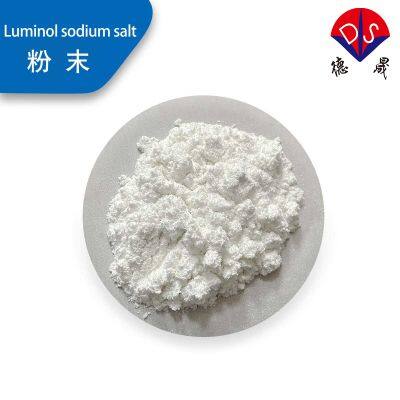Home > Products > Chemiluminescence reagent > Introduction and Precautions of Luminol Monosodium Salt 20666-12-0
Introduction and Precautions of Luminol Monosodium Salt 20666-12-0
100 - 499 Grams
500 - 999 Grams
≥1000 Grams
- Shanghai
- T/T L/C PayPal Western Union
- 5 days
You May Like
-
Isoluminol Reagent for Chemiluminescence
-
Luminescence Analysis of High-purity Acridine Ester NSP-DMAE-NHS194357-64-7
-
Direct Chemiluminescence of Acridine Ester DMAE-NHS 115853-74-2
-
Detailed Introduction of Luminescent Reagent NSP-SA 211106-69-3
-
Stability and Precautions of Acridine Ester (NSP-SA-NHS)
-
The Labeling Principle and Application of Acridine Hydrazide NSP-SA-ADH
Product Details
| CAS No. | 20666-12-0 |
Product Description
Luminol monosodium salt, also known as 3-amino-phthalic anhydride monosodium salt in Chinese, has a CAS number of 20666-12-0 and a molecular formula of C8H8N3NaO2. It has good water solubility and is a commonly used chemiluminescence reagent. Due to differences in manufacturing processes among different manufacturers, the appearance of luminol monosodium salt commonly seen on the market is light green, pale yellow, or off white powder. Among them, off white luminol monosodium salt powder is more widely recognized and needs to be prepared into a solution when used.
Luminol sodium salt
Luminol monosodium salt is a derivative of Luminol luminescent ammonia, so there are many similarities in its use: firstly, Luminol and Luminol monosodium salt require catalysis to emit light, and both can be used to detect bloodstains. In contrast, luminol monosodium salt is more suitable for detecting bloodstains because luminol is an acidic substance that is insoluble in water and soluble in alkaline solutions, while luminol monosodium salt is soluble in water and has a pH value closer to that of human blood, both approaching 7.
The use of luminol monosodium salt is not only for detecting bloodstains and crime scenes, but also for detecting peroxidase. It is also a sensitive probe for metal ion mediated oxidation reactions and a commonly used reagent for chemiluminescence analysis of metal cations and glucocorticoids. It can also be used for imaging myeloperoxidase activity in vivo. In summary, the use of luminol monosodium salt is very flexible and extensive.
Luminol monosodium salt powder or solution should be stored away from direct sunlight and high temperatures. During experiments and use, direct contact with the skin should be avoided as much as possible. In order to ensure the safety and health of experimenters, it is recommended to wear lab coats and disposable gloves as much as possible. The technology of producing luminol monosodium salt by Hubei Xindesheng Material Technology Co., Ltd. is very mature, with stable production process and small inter batch differences, which can ensure that the appearance is a white powder. If you need it, you can contact me or click on the official website to learn more details!
Contact Us

- Hubei New Desheng Material Technology Co., Ltd
- Contact nameDoris Yang Chat Now
Product Categories
| Additive for blood collection | Biological buffer | Chemiluminescence reagent | Chromogenic substrate |
| enzyme preparation |
New Products
-
Application and pH Stability of Acetyl CoA Oxidase
-
Tris and Glutamate Dehydrogenase Work Together on Homocysteine Assay Kit
-
The Relationship Between Purine Nucleoside Phosphorylase and Nucleic Acid Synthesis and Decomposition
-
Introduction of Desheng on Alpha Glucosidase
-
Glucose Dehydrogenase: a Key Enzyme in IVD in Vitro Diagnostic Reagents
-
Detailed Explanation of Storage Methods for Adenosine Deaminase (ADA)
-
Biological Functions and Applications of Malate Dehydrogenase
-
The Price of TRIS-HCL 1185-53-1 Produced by Desheng Has Been Lowered. Please Feel Free to Consult and Purchase
-
Why Should we Pay Attention to Solubility When Purchasing Biological Buffer TRIS 77-86-1?
-
The Effect of Purity of BICINE Powder 150-25-4 as a Biological Buffer on the Performance of Buffer Solutions
-
Introduction to the Transportation Packaging of CAPS Powder 1135-40-6, a Biological Buffering Agent
-
Compatibility of Biological Buffer MOPS 1132-61-2 With Other Reagents
-
Application of Biological Buffer TAPS 29915-38-6 in Enzyme Activity Research
-
The Advantage of High Purity of EPPS Powder 16052-06-5 Raw Materials for Biological Buffering Agents
-
Advantages of MOPSO Buffer 68399-77-9 in Low-temperature Biochemical Work
-
What Does HEPES Buffer 7365-45-9 do for Cell Culture
-
Application of Biological Buffer PIPES 5625-37-6 in Biochemical Research
-
How to Determine and Choose a BES Buffer 10191-18-1 Manufacturer for Procurement
-
Biological Buffer DIPSO (68399-80-4) Detailed Description for Quick Understanding
-
Multiple Applications of CHES Buffer in Biological Research
-
Advantages of High TOOS Molar Absorbance
-
How to Obtain High-quality TOPS Powder as a Chromogenic Substrate
-
Stability and Storage Conditions of ADOS Products as Chromogenic Substrates
-
The Simplicity of ADPS Colorimetric Reagent in Experimental Operation
Popular Searches
Recommended Products
- Sodium Metasilicate Granular 25kg Powder
- Chlorine Dioxide Quick Test Kit
- Residual Chlorine Quick Test Kit
- Rapid Determination of Available Chlorine
- Quaternary Ammonium Sanitizer Concentration Test Strips [0~4000 Ppm]
- Quaternary Ammonium Sanitizer Concentration Test Strips [0~1000 Ppm]
- You Need to Pay Attention to These Three Erroneous Views When Purchasing Carbopol Powder
- Exploration of the Advantages of MAOS Chromogenic Substrates in Biochemical Detection
- Application of MADB 209518-16-1 in Serum Muscle Enzyme Detection Kit
- Basic Information of the New Trinder's Reagent HDAOS Powder Reagent
- What Items Can DAOS, a Chromogenic Substrate, be Used to Detect?
- Packaging Requirements for Exporting Color Developing Substrate ALPS Powder in Small Batches
Find Similar Products By Category
- Chemicals > Chemical Reagent
- Please Enter your Email Address
- Please enter the content for your inquiry.
We will find the most reliable suppliers for you according to your description.
Send Now-
 Doris Yang
Hi there! Welcome to my shop. Let me know if you have any questions.
Doris Yang
Hi there! Welcome to my shop. Let me know if you have any questions.
Your message has exceeded the limit.

- Contact supplier for lowest price
- Customized Request
- Request Sample
- Request Free Catalogs
Your message has exceeded the limit.
-
Purchase Quantity
-
*Sourcing Details
Your inquiry content must be between 10 to 5000 characters.
-
*Email
Please enter Your valid email address.
-
Mobile



